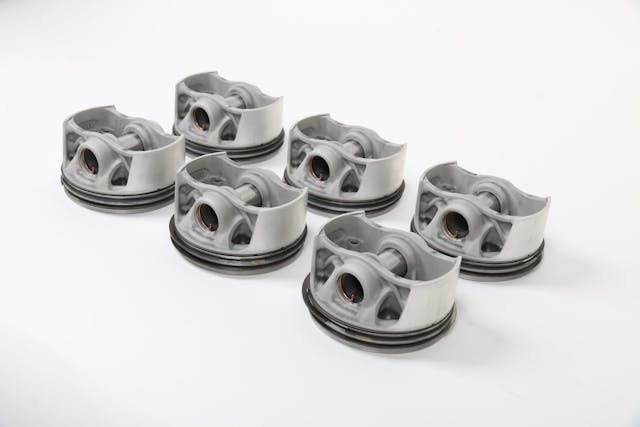Porsche and Mahle produce 3D-printed pistons for lighter weight and improved power
As we keep learning, there are dozens of ways that 3D printing can help keep cars on the road. Home hobbyists can quickly prototype parts that will eventually be machined from metal, and plastic bits straight from the printer can replace broken interior trim. BMW even uses 3D-printed cores to cast the cylinder heads of its S58 engines.
What we did not expect to see—at least not yet—were 3D-printed pistons that could survive in some of the most grueling racing applications possible. However, Porsche and parts manufacturer Mahle have apparently accomplished just that, with lightweight pistons for the 911 GT2 RS that shave weight and improve cooling. Even more importantly, the components have survived some hardcore bench testing.
The joint project involves Porsche, Mahle, and the engineering firm Trumpf. The companies use laser metal fusion (LMF) that melts powdered aluminum one layer at a time to build each piston before it’s machined just like a cast or forged piston. Mahle uses a proprietary alloy similar to one it developed for cast pistons. The design process uses “bionic design,” drawing inspiration from efficient biological systems that add material and mass only where necessary. The resulting piston is up to 20 percent lighter than its traditional forged counterpart and more rigid.

The LMF process is time-consuming—it takes 12 hours to stack the 1200 layers that comprise each batch of pistons— but the resulting parts cannot be made using traditional casting or forging techniques. One of the most interesting aspects of the piston is the cooling gallery, a feature enabled specifically by 3D printing. A passage near the piston crown allows the piston oil squirters to do their job more effectively by giving the oil a path to remove heat from one of the hardest-working parts of the piston.

After the 3D-printed pistons pass all of the same laboratory tests as conventionally-manufactured examples, the next step is to run them in a test engine. Porsche and Mahle cooked up a 200-hour endurance torture test that included 135 hours of full-load operation. Not only did the parts survive 6000 km (3728 miles) at an average speed of 250 km/h (155 mph), but their lower weight allowed the 3.8-liter turbocharged flat-six to rev 300 rpm higher and dish out an additional 30 hp. That may not seem like a lot of additional output on an engine that already churns out 700 hp, but it represents more than a four percent improvement, a huge jump when you consider that Porsche’s engineering team didn’t leave a lot of power on the drawing board when they were done with the GT2 RS.
Besides being able to manufacture parts that would be impossible to forge or cast, this 3D-printing process also eliminates the need for special tooling. Because the exact component can be printed on-demand, there is no need to make large batches of surplus parts (in this case, pistons). When it is time to rebuild that GT2 RS, many race seasons down the line, its pistons won’t be “out of production.”
As this technology increases in scale and scope, we hope that the more popular vintage engines get this same sort of treatment.


